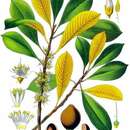en
names in breadcrumbs


Palaquium is a genus of trees in the family Sapotaceae that includes around 110 species with representatives occurring from Taiwan and Indomalesia (i.e., India to New Guinea) to Samoa. The genus is best known as the source of gutta-percha, a product obtained from the latex of the tree (mainly P. gutta of Sumatra, Malaya, Java, and Borneo) after tapping or cutting it down. This rubbery substance, which softens when heated, had many uses historically (including as an insulator for the first trans-Atlantic telephone cables and in the manufacture of golf balls) and is still used in dentistry. After early destructive tapping, some plantations were established in Java and Singapore. (Heywood 1993; Mabberley 2008)
Like rubber, gutta-percha is composed mainly of a polymer of isoprene, but it differs from rubber in having trans- rather than cis- isomerization, in that it is almost non-elastic, in that it is a better insulator of heat and electricity, and in that it becomes plastic when heated and upon cooling retains the shape acquired when it was heated (Heywood 1993).
Gutta-percha has a rich history (Brown 2003)but its only common use today is in dentistry (Tronstad 2009) and there are active efforts by dental researchers to replace its with other materials (e.g., Baba et al. 2010).
The genus Palaquium includes around 110 species, with representatives occurring from Taiwan and Indomalesia (i.e., India to New Guinea) to Samoa (Mabberley 2008).